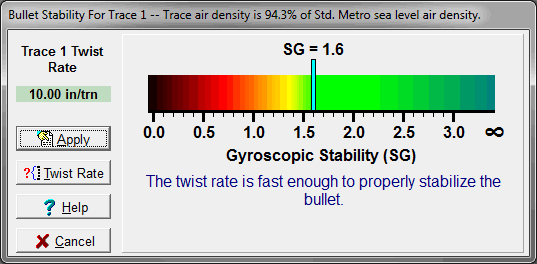|
Bullet Stability and Twist Rate Calculator For a bullet to be stable in flight it needs to be spinning fast enough to resist aerodynamic upsetting forces. The Bullet Stability and Twist Rate Calculator is based on the Miller stability formula and rules with enhancements to account for humidity. To be properly stabilized, a bullet should have a gyroscopic stability factor (SG) of 1.4 or higher, with 1.5 now being recommended as the minimum by some experts. It's not uncommon or detrimental to have SG values up to 3.0, but be aware that as SG increases so does spin drift and sensitivity to any flaws in the distribution of the bullet's mass around the axis of rotation. Such flaws cause the bullet to wobble in various ways depending on the location of the mass imbalance, and may affect accuracy. |
||
| The Bullet Stability and Twist Rate Calculator is opened by clicking on the units label (in/trn or cm/trn) just to the right of the Barrel Twist parameter that's visible when Spin Drift is turned on. |  |
|
|
When first opened the dialog displays the twist rate and atmospheric density specified in the Trace from which the dialog was opened along with the calculated gyroscopic stability factor (SG) and caption for those parameters. Note that Ballistic Explorer uses an advance hybrid atmospheric model that accommodates the Metro standard sea level conditions for which the official SAAMI drag functions are calibrated, yet uses the modern ICAO atmosphere for deviation from standard Metro conditions while incorporating real world humidity levels (ICAO specifies an improbable humidity of 0 percent). |
||
| To obtain the suggested twist rate click the Twist Rate button. The suggested twist rate is rounded to the nearest half inch or centimeter that results in a gyroscopic stability factor of at least 1.5 at ICAO sea level air density. |  |
|
|
Click the Apply button to calculate and apply the suggested Twist Rate to the Trace window's Barrel Twist parameter. Besides using a faster barrel twist rate (less distance per turn), other factors that increase the gyroscopic stability factor include increasing the muzzle velocity or using a shorter bullet. While the gyroscopic stability factor increases with bullet weight, for a given caliber, a heavier bullet's increased length more than offsets the gain and actually reduces gyroscopic stability. However, if using a copper or copper alloy bullet, changing to a metal jacket lead bullet of the same weight increases gyroscopic stability because of lead's higher density, and thus, shorter bullet length for the same weight. Note that as air density decreases, such as at higher altitude and warmer air temperature, gyroscopic stability increases. A load for a given gun can be comfortably stable on a warm day at higher altitude and quite unstable at lower altitude and cooler temperatures. To check if that might be an issue, click the Twist Rate button and compare the suggested Twist Rate to that of the Trace window's Barrel Twist parameter. You should be cautious about using the given load in a gun with a barrel twist rate slower (more distance per turn) then the suggested Twist Rate unless you know it won't be used in denser air (low altitude and/or low temperature).
|
||